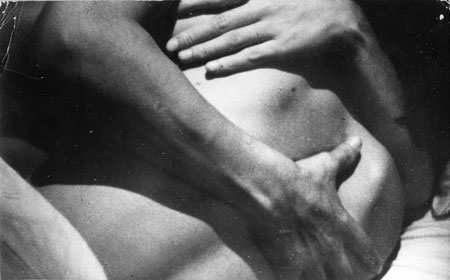
| 85 |

|
| 86 |

|
| 87 |

|
| 88 |

|
| 89 |

|
| 90 |

|
| 91 |

|
| 92 |

|
| 93 |
|
| 94 |
|
| 95 |
|
| 96 |
|
| 97 |
|
| 98 |
|
| 99 |
|
| 100 |
|
2008: Rank | Title | Year
All reviews © Nick Davis
Author's permission must be granted in writing for any duplication or publication.
Browse Films by
Title / Year / Reviews
Nick-Davis.com
Home / Blog / E-Mail
 #88: Hiroshima mon amour
#88: Hiroshima mon amournew entry dir. Alain Resnais, 1959 scr. Marguerite Duras; cin. Sacha Vierny and Michio Takahashi with Emmanuelle Riva, Eiji Okada, Bernard Fresson IMDb // Leave a Comment In 100 Words: What did you see in Hiroshima? You saw nothing. No, I saw everything. These questions and rebuttals volley across the virtuoso opening of Alain Resnais's and Marguerite Duras's masterpiece, blending his trademark interrogations of memory with her insistent repetitions and erotic audacity. After 15 minutes of stunning montage, daring to cross-cut harrowing documentary footage with boudoir tableaus, the tense romance between She (Emmanuelle Riva) and He (Eiji Okada) might appear trivial or bourgeois. But this, surely, is the film’s point and challenge: how to encounter the other, how to think, love, or survive, in the wake of literally blinding trauma? Food for Thought: Hiroshima mon amour has been studied so extensively and debated so ardently, there are any number of worthy paths to follow into or out of the film. Rather than anointing a "best," I'll single out my first: I initially saw the movie in graduate school, in tandem with reading Cathy Caruth's "Literature and the Enactment of Memory," from Unclaimed Experience: Trauma, Narrative, and History (Baltimore: Johns Hopkins UP, 1996): 25-56; Peter Schwenger's essay "Hiroshima in the Morning," in Thinking Bodies, ed. Juliet Flower MacCannell and Laura Zakarin (Stanford: Stanford UP, 1994): 109-119; and Sharon Willis's "Hiroshima mon amour: Screen Memories," from Marguerite Duras: Writing on the Body (Urbana-Champaign: University of Illinois Press, 1986): 33-62. Yes, more recent investigations of this film exist, but as She and He remind us, sometimes you can't escape your own starting-points. |
| Permalink | Top 100 | Home | Blog |